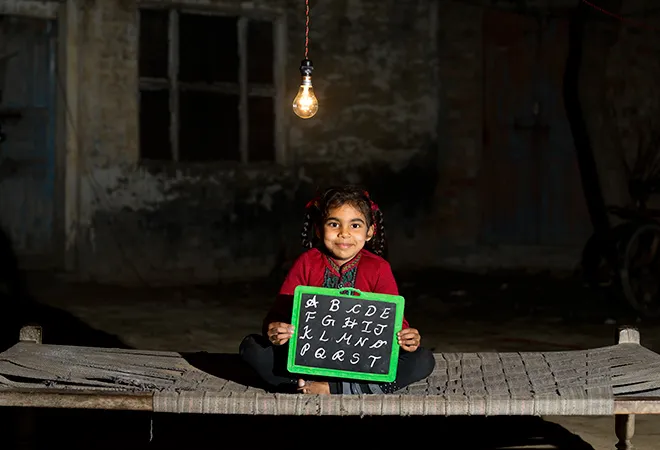
Electrification of 99.99% <1> of the households in India is a major milestone towards attaining the Sustainable Development Goal target 7.1 of providing universal access to affordable, reliable, and modern energy services by 2030. Budget 2020 proposes an outlay of INR 22,000 crores for reliable electricity to all (ET Government, 2 February 2020). The government’s aim of providing a 24x7 supply of power to households would, however, demand further strengthening of power infrastructure. However, in this process, it is also important that the sustenance of the existing connections is assured.
The Centre for Energy, Environment and Water's (CEEW) energy access survey of 8500 rural households across six energy-deprived states indicates that two-third of the households without electricity (about 30%) were not able to afford or chose not to pay for the electricity (CEEW, Columbia University, Practical Action, 2016). The survey also concluded about a 30% difference in mean monthly expenditure between electrified and un-electrified households. Even in the newly electrified villages (receiving electricity about 2-3 months back), households receiving higher electricity bills expressed their inability or unwillingness to pay for electricity. <2> Affordability and willingness to pay remains an important factor for retaining a household's access to electricity and ensuring that households do not revert to the “no electricity” tier. (Please refer to the figure below).
Figure 1: Tiers of household electricity supply and the role of affordability and willingness to pay in retaining electricity supply

ESMAP (Energy Sector Management Assistance Programme) in their Multi-tier Matrix for measuring access to household electricity supply identifies affordability as the cost of a standard consumption package of 365 kWh <3> /year and is less than 5% of household income (ESMAP, 2015). In India, the differential tariff <4> for domestic consumers, and further lower tariff for Below Poverty Line (BPL) consumers is a measure to address the affordability issue. In most of the states, the first 30-50 units of electricity consumed are free which is essential for basic lighting purposes. <5> Despite these measures, many households opt not to pay for electricity. The reasons being the seasonal nature of the agricultural income, lack of regular income, high electricity bills, and unexpected expenditures in the households. More flexibility in the payment time for electricity, such as discontinuation of electricity due to nonpayment dates extending over six months, may bring respite to the poor consumers. Another option may be the provision of payment of electricity bills on installments or the provision of small loans for payment of electricity may also be considered.
More flexibility in the payment time for electricity, such as discontinuation of electricity due to nonpayment dates extending over six months, may bring respite.
One another reason for not choosing to pay for electricity is electricity bills being high presumed by the consumers. <6> In such cases, the consumers are not able to understand the actual reason for increased electricity bills, and the response they receive in electricity offices are felt to be unsatisfactory. Awareness of tariff pattern and the anticipated irregularities in billing systems may be created among the users. A grievance redressal visit at the village level or user-friendly redressal mechanism at local electricity offices may at least provide for a satisfactory explanation to the consumer for their increased electricity bills. Random monitoring of the bills and meters may also be conducted to reduce faults in generating electricity bills.
In the year 2018, government announced to make all electricity meters as smart and prepaid meters within three years (ET Energy World, 24 December 2018). The introduction of prepaid meters would provide the flexibility of payment to the consumers. The prepaid meters in the scenario of not being able to recharge would also lead to discontinuation of electricity supply.
The reliability of power supply is also an important factor for creating a willingness to pay by poor consumers. However, the issues related to long power cut hours have reduced to a considerable extend. Power cuts are however observed for few days in continuation due to faults or reasons such as floods.
The reliability of power supply is also an important factor for creating a willingness to pay.
One of the ways of addressing the affordability and reliability of power supply is the bundling of household electrification with conventional electricity and solar-based household electrical system. The Numaligarh Refinery Limited (NRL) in association with The Energy and Resources Institute (TERI) installed Solar based household electricity systems in the unelectrified households in district Golaghat of Assam using its Corporate Social Responsibility funds (The Energy and Resources Institute, 2020). Eventually, the un-electrified households received conventional electricity connections. The households with solar-based household electricity systems and conventional electricity indicated that their electricity bills were much lesser than the households depending on only conventional electricity. Again, the households with Solar based household electricity system mentioned that their supply of power was reliable while the households depending only on conventional electricity had to rely on kerosene for lighting during power cuts.
SDG 7.1 emphasises on reliability and affordability of the electricity supply. Unlike the reliability factor, affordability, and willingness to pay largely depends on the consumer. Thus, affordability is a much trickier factor to deal with to help consumers from economically poor sections to retain their electricity supply. The mere counting of the number of legal household connections may not lead to the actual achievement of the goal of universal access to electricity. Much more flexibility in the payment patterns along with smart prepaid metering is required for retaining uninterrupted electricity supply in rural areas.
After achieving 100% electrification of rural households, the next step, along with the strengthening of infrastructure to provide 24x7 electricity, is to ensure that the households can retain their electricity connections.
References
CEEW, Columbia University, Practical Action. (2016). Measuring Energy Access in India.
ESMAP. (2015). Beyond Connections - Energy Access Redefined. Retrieved October 03, 2020.
ET Energy World. (December 24, 2018). Government plans to make all electricity meters smart prepaid in 3 years. Retrieved October 08, 2020.
ET Government. (February 02, 2020). Budget 2020: Govt to convert all electricity meters into smart prepaid meters by 2022. Retrieved October 08, 2020.
The Energy and Resources Institute. (2020). TERI Reports.
<1> https://saubhagya.gov.in/
<2> Author’s interaction in the villages of Golaghat district of Assam during early March 2020.
<3> Kilowatt-hour
<4> Different electricity rates based on the consumption of the number of units. For example, for the consumption of the first 5 units, the tariff may be INR 4 per unit and for the consumption of the next 10 units, the tariff may increase to INR 6 per unit.
<5> Based on interaction with a power sector expert.
<6> Author's interaction with the rural communities across various states over a decade in the context of different studies
The views expressed above belong to the author(s). ORF research and analyses now available on Telegram! Click here to access our curated content — blogs, longforms and interviews.





 PREV
PREV


